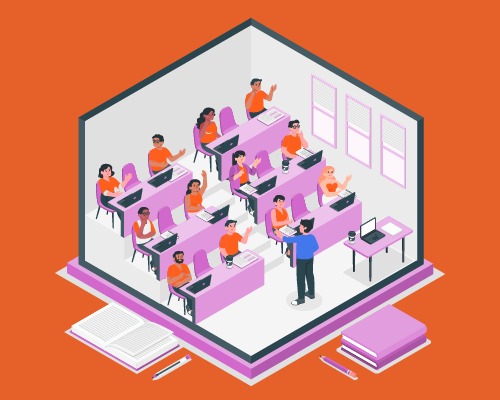How Strong Teacher-Student Bonds Can Help Both Students and Teachers Grow

Imagine a classroom where students eagerly anticipate each lesson, not just for the subject matter but because they share a unique bond with their teachers. This transformative effect can come from fostering meaningful student-teacher relationships. It not only helps improve students’ academic performance but also drives professional growth for teachers. Let us explore these profound connections and understand the impact they have on academic success, personal development and the advancement of a teacher’s career.
Understanding Student-Teacher Dynamics
Understanding the intricacies of student-teacher relationships is pivotal to creating an environment where students not only learn but flourish. Let us dive deeper.
Why Do Student-Teacher Bonds Matter?
Positive student-teacher relationships can have a tremendous impact on their performance in the classroom. Students who feel that their teachers care about their success and well-being are more likely to be engaged and motivated learners. This can lead to improved academic performance and even better mental and emotional well-being. Moreover, strong teacher-student bonds provide the support that helps students navigate challenges and overcome obstacles.
These bonds can also extend beyond the academic realm. Students often turn to their trusted teachers for guidance on personal matters, career choices, and life advice. This shows that the impact of a positive student-teacher relationship can last a lifetime.
Strong student-teacher relationships can also have a tremendous impact on the teacher’s career. Teachers who form meaningful connections with their students often experience higher job satisfaction. If connecting with your students can lead to better class performance, it can reflect well on your performance as a teacher too. This may drive better career prospects.
Building bonds fosters open communication and trust. This environment can encourage constructive feedback and collaboration. This commitment to professional growth can open doors to career advancement opportunities, such as leadership roles within the school. What’s more, teachers who form lasting bonds with their students often benefit from these connections in the long run since former students can become valuable references or even professional contacts in various fields.
Common Challenges in Building Student-Teacher Bonds
Building strong student-teacher bonds isn’t always straightforward. Teachers often face challenges such as large class sizes, diverse student backgrounds, and limited time. However, understanding these obstacles is the first step toward overcoming them.
Large class sizes can make it challenging to provide individual attention to each student. However, even in larger classes, teachers can take steps to connect with their students. Allocating a few minutes at the beginning or end of each class for one-on-one conversations can make a significant difference. It is also vital to provide personalized feedback to each student. With access to digital tools like the Extramarks Teaching App, teachers can find out each student’s strengths and weaknesses on the analytics dashboard. These can be shared with the students in feedback sessions.
Furthermore, diversity can also pose a significant challenge. Educators must be sensitive to cultural differences in the class and the varying needs of their students. To address this, teachers can learn about and respect their students’ cultural backgrounds, ensuring that their teaching methods are inclusive and respectful.
Limited time is also a major constraint. Teachers can use various resources like educational videos or virtual reality to make even the shortest lectures more interesting. Teachers can also schedule extra classes to make sure that the students who are falling behind receive additional attention in order to improve their performance. Consistency in their interactions is a vital aspect teachers need to consider. By being consistent, they can build trust with their students over time.
Strategies for Fostering Meaningful Student-Teacher Bonds

Creating strong student-teacher bonds will certainly require a strategic approach on the teacher’s part. Let’s explore five key strategies to foster these connections effectively.
1. Building Trust and Rapport
Building a rapport with your students is a process that requires both time and effort. Start by being transparent with your expectations as well as your actions. Your students should always know how you will react and trust that you’ll be fair with them. They need to know what you want of them and work towards goals that you have clearly set. Being approachable is also an essential aspect of building trust. Encourage open communication, and let your students know that they can come to you with questions or concerns without fear of judgment. Furthermore, ensure that you show genuine interest in their lives and hobbies. Remembering a student’s interests and asking about them can go a long way in making them feel valued. Also, always keep your promises. If you say you’ll do something, follow through with it. Slowly but surely, they will start to trust you and value your bond.
2. Effective Communication
Communication is a two-way street. It involves conveying information clearly and also actively listening to your students. When your students will feel heard, they will be more likely to engage in meaningful conversations with you. Provide them with opportunities to express themselves and encourage them to ask questions. Participate in discussions in the classroom. Acknowledge the thoughts and opinions shared by your students. Respectful disagreements can also be a learning opportunity. To communicate well, use clear and concise language, especially when explaining complex concepts. Avoid jargon or unnecessary technical terms that might confuse students. Aim to be as straightforward as possible to ensure that the students understand the material.
3. Personalisation in Teaching
When it comes to education, one size never fits all. Each student is unique. They have unique learning styles, interests, and abilities! Personalizing your teaching approach is essential to cater to these individual differences. By using digital platforms like the Extramarks Teaching App, you can cater to each individual student’s learning levels by adapting your teaching style to meet their unique needs. This will help you offer your students assignments with variable difficulty based on their skill levels. Also, providing regular feedback will help you to highlight each student’s progress and offer suggestions for improvement. When students see that you are invested in their growth, they are more likely to form a bond with you as their mentor.
4. Empathy and Emotional Intelligence
Empathy is the ability to understand and share the feelings of others. It’s a vital component of building meaningful student-teacher bonds. To develop empathy, put yourself in your students’ shoes. Understand their perspectives and emotions. When a student faces a difficult situation, whether academic or personal, offer support and empathy. Sometimes, simply acknowledging their feelings and offering a listening ear can make a world of difference in offering comfort as well as improving your bond with them. Use your emotional intelligence to pick up on cues and adapt your approach to each student’s emotional state. Building empathy is an ongoing process, but it’s one of the most rewarding aspects of teaching. When students know you genuinely care about their well-being, they are more likely to trust and connect with you.
5. Encouraging Student Participation
Active student participation is a key ingredient in forming meaningful bonds. Create an inclusive classroom environment where all students feel valued and heard. To do this, encourage collaboration and group activities that promote teamwork and peer interaction. When students feel like they are part of a supportive community, they are more likely to connect not only with their peers but also with you as their teacher. Further, asking open-ended questions can encourage critical thinking and discussion. When you actively engage with your students in these ways, you create opportunities for deeper connections to form.
Impacts of the Digital Age
In today’s digital age, technology plays a pivotal role in education, transforming the way students and teachers interact. Let’s explore how the digital landscape has influenced student-teacher dynamics, offering both opportunities and challenges.
Leveraging Technology to Strengthen Relationships
Technology has opened several new avenues for teachers to connect with their students. Online platforms like Extramarks Smart Class Plus provide educators with tools to engage students. Their game-based content, interactive learning formats and extensive question bank help keep students engaged! Digital channels like these help make it easier for students to reach out to their teachers and clear their doubts at any time. This shows the students that the teacher is always available to support them. What’s more, the extensive learning resources offered facilitate better discussions. Extramarks’ instant evaluation feature ensures that students receive feedback on their performance instantly. This accessibility can bridge the gap between in-person interactions and create opportunities for students to connect with their teachers outside of regular class hours. Furthermore, analytics can assist in tracking student progress, allowing you to identify areas where individual students may need additional support. This data-driven approach can help tailor instruction to meet students’ specific needs, further strengthening the teacher-student bond.
The Balance Between Digital and In-Person Interactions
While technology offers valuable tools, it’s essential to strike a balance between digital and in-person interactions. Face-to-face connections remain irreplaceable, as they provide opportunities for nonverbal communication such as facial expressions and body language. These nonverbal cues are crucial for building trust and understanding. In-person interactions also enable spontaneous discussions and immediate feedback. Students can ask questions and receive answers in real-time, fostering a sense of immediate connection and support. It’s in these moments that the foundations of trust and rapport are often solidified.
However, technology can bridge geographical gaps and provide flexibility. It allows teachers to connect with students who might not have access to in-person instruction. Digital tools offer convenience, enabling students to learn at their own pace while staying connected with their educators. The key lies in finding the right balance. Consider the unique needs of your own students and work towards building a strong and long-lasting bond with them.
Last Updated on February 17, 2025
Reviewed by

Prachi Singh | VP - Academics
Prachi Singh is a highly accomplished educationist with over 16 years of experience in the EdTech industry. Currently, she plays a pivotal role at Extramarks, leading content strategy and curriculum development initiatives that shape the future of education...read more.










